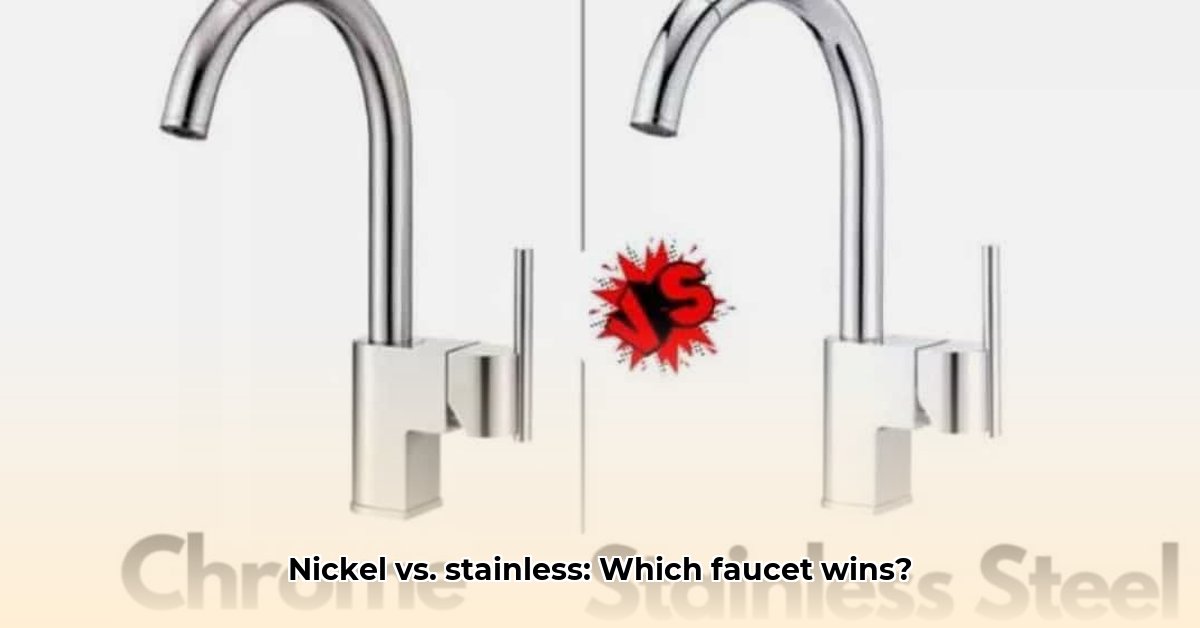
Choosing the perfect kitchen faucet can be a daunting task. With countless finishes available, brushed nickel and stainless steel consistently emerge as top contenders. This guide offers a comprehensive comparison to help you make an informed decision.
Understanding the Materials: Beyond the Surface
Before diving into aesthetics and durability, let's clarify the fundamental differences between brushed nickel and stainless steel faucets.
Brushed nickel isn't solid nickel; it's a finish applied to a base metal (often zinc or copper). This process creates a warm, slightly golden tone and a subtly textured surface. Think of it as a decorative coating.
Stainless steel, however, is an alloy – a blend of metals, primarily iron, chromium, and nickel. This alloy composition provides superior strength and corrosion resistance, resulting in a smooth, cooler, slightly bluish tone. This inherent material difference significantly impacts their performance over time.
The Look and Feel: A Style Showdown
Personal preference heavily influences the choice between these finishes. Brushed nickel projects a softer, more traditional aesthetic. Its textured surface diffuses light, creating a warmer, more elegant feel, often preferred in kitchens with traditional or transitional décor.
Stainless steel, conversely, exudes a modern, sleek appeal. Its smooth, reflective surface creates a clean, contemporary look, perfectly complementing minimalist or modern kitchen designs. The subtle blue undertones add sophistication.
Durability and Longevity: The Test of Time
The longevity of a faucet depends on both the finish and the overall quality of construction. A high-quality brushed nickel faucet can be surprisingly durable, withstanding corrosion effectively due to its protective finishing process. However, higher grade stainless steel typically edges out brushed nickel in inherent durability due to the superior corrosion resistance granted by its chromium content.
Key Takeaway: Regardless of your choice, always prioritize reputable brands known for their robust manufacturing processes. A well-made faucet, regardless of finish, will significantly outlast a poorly constructed one.
Maintenance and Cleaning: Effort vs. Reward
Here, the finishes reveal interesting contrasts. Brushed nickel's textured surface is remarkably forgiving, effectively concealing fingerprints and water spots. This translates to less frequent cleaning.
Stainless steel's highly reflective surface, while visually striking, showcases every imperfection. While easily cleaned, it demands more regular attention to maintain its pristine appearance. Both finishes clean easily with mild soap and water; however, stainless steel may require more frequent cleaning for a consistently spotless look.
Cost Considerations: Budgetary Implications
Generally, brushed nickel faucets tend to be more affordable upfront than stainless steel. However, pricing significantly varies based on brand, model, and retailer. High-end options exist in both finishes, and the price differential often reflects variations in material quality and manufacturing processes. Always compare prices from multiple sources before committing.
Pros and Cons: A Comparative Summary
The following table summarizes the key advantages and disadvantages of each finish:
| Feature | Brushed Nickel | Stainless Steel |
|---|---|---|
| Appearance | Warm, textured, slightly golden hue | Cool, smooth, slightly bluish hue |
| Durability | Good, dependent on manufacturing quality | Excellent, especially with higher-grade alloys |
| Maintenance | Low; hides imperfections | Higher; shows fingerprints and water spots |
| Cost | Typically less expensive | Typically more expensive |
| Corrosion Resistance | Good but less inherently resistant than stainless steel | Excellent |
Making the Final Decision: Your Kitchen's Personality
The optimal choice depends on your individual preferences, budget, and lifestyle. Consider the existing décor, your willingness to dedicate time to cleaning, and your long-term budget. There's no universally "better" option; the perfect faucet perfectly aligns with your specific needs and kitchen style.
Three Pivotal Points to Consider:
- Aesthetics: Which finish better complements your kitchen's overall design?
- Maintenance: How much time are you willing to spend on cleaning?
- Budget: What's your price range for a new faucet?
Actionable Steps to Choosing the Right Faucet:
- Assess your kitchen style: Identify the dominant design elements (modern, traditional, transitional).
- Determine your cleaning tolerance: Are you a meticulous cleaner or prefer low-maintenance options?
- Set a budget: Define a realistic price range.
- Research brands and models: Compare faucets within your budget and desired finish.
- Read reviews: Seek feedback from other homeowners.
- Visualize: Imagine each finish in your kitchen to ensure a harmonious blend.
By carefully considering these factors, you can confidently select the kitchen faucet that perfectly balances style, functionality, and your personal preferences, ensuring years of enjoyment.